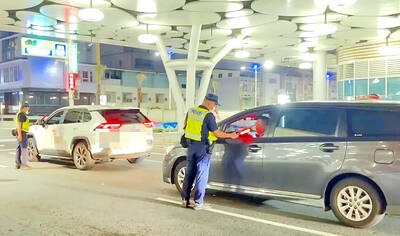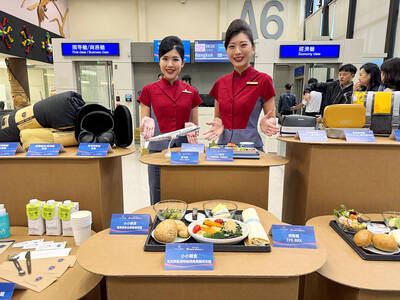Even though the student occupation of the Ministry of Education’s forecourt to protest against high-school curriculum guideline changes ended on Thursday last week due to the approach of Typhoon Soudelor, student leaders yesterday said that the experience of confronting the nation’s bureaucracy has not dulled their passion for social justice and vowed to continue their activism.
Critics of the controversial changes to high-school curriculum guidelines, which led to the widespread student protests, allege the adjustments impose a China-centric view on history education and obscure the history of the White Terror during the nation’s Martial Law era, when civil liberties were suspended and major incidents of political repression, such as the 228 Incident in 1947, were perpetuated by the then Chinese Nationalist Party (KMT) government.
“We learned how to become truly courageous,” said Liao Chun-lun (廖崇倫), a senior member of the Apple Tree Commune, a student club at Taichung First Senior High School that was the first student body to publicly criticize the planned adjustments to the high-school curriculum guidelines.
Liao conceded that fighting the government’s bureaucracy was tremendously stressful, especially after the public conference with Minister of Education Wu Se-hwa (吳思華), in which Wu rejected many of their demands.
Students said that Wu repeated the government’s stance last month “like a broken record” and that they were dejected, because their efforts were met with insincerity from the ministry.
Liao said he persisted, because he did not want to let the public down or see the protest to fail, adding that he plans to continue to be active in causes involving his school and neighborhood.
Apple Tree Commune spokesperson Chen Chien-hsun (陳建勳) said the protest was about the principle that education should be objective and fair, adding that after three months protesters had successfully drawn the public’s attention to the “black-box curriculum revisions.”
Chen said he also learned that confronting government bureaucracy is difficult, adding that the movement would continue as the students plan to practice activism in their neighborhoods and schools in the form of speaking events on the street.
Apple Tree Commune member Hsiao Chu-chun (蕭竹均) said the protest awakened the social consciousness of high-school students and provided the impetus for their participation in public affairs.
Unfortunately, he added, the government decided to hide behind barbed wire.
He said that his greatest fear is that other students might quit the movement out of despair over the government’s indifference, appealing to his fellow protesters to not lose hope and stay engaged in social issues, “because there is so much that deserves engaging.”
Meanwhile, Taipei Mayor Ko Wen-je (柯文哲) is scheduled to meet with students today to discuss the incursion into the ministry compound last month.
A group of students, citing their dissatisfaction with the ministry’s failure to respond in a substantial manner to their demands, broke into the ministry compound on July 23.
The police arrested 33 people including three journalists, which sparked accusations that the police had infringed on the freedom of the press.
Ko later apologized for the arrest of the journalists and convened a special task force led by Taipei Deputy Mayor Teng Chia-chi (鄧家基) to investigate the Taipei police department’s conduct in the incident.
Additional reporting by Ko Chia-an

TRAFFIC SAFETY RULES: A positive result in a drug test would result in a two-year license suspension for the driver and vehicle, and a fine of up to NT$180,000 The Ministry of Transportation and Communications is to authorize police to conduct roadside saliva tests by the end of the year to deter people from driving while under the influence of narcotics, it said yesterday. The ministry last month unveiled a draft of amended regulations governing traffic safety rules and penalties, which included provisions empowering police to conduct mandatory saliva tests on drivers. While currently rules authorize police to use oral fluid testing kits for signs of drug use, they do not establish penalties for noncompliance or operating procedures for officers to follow, the ministry said. The proposed changes to the regulations require

The Executive Yuan yesterday announced that registration for a one-time universal NT$10,000 cash handout to help people in Taiwan survive US tariffs and inflation would start on Nov. 5, with payouts available as early as Nov. 12. Who is eligible for the handout? Registered Taiwanese nationals are eligible, including those born in Taiwan before April 30 next year with a birth certificate. Non-registered nationals with residence permits, foreign permanent residents and foreign spouses of Taiwanese citizens with residence permits also qualify for the handouts. For people who meet the eligibility requirements, but passed away between yesterday and April 30 next year, surviving family members

China Airlines Ltd (CAL) yesterday morning joined SkyTeam’s Aviation Challenge for the fourth time, operating a demonstration flight for “net zero carbon emissions” from Taiwan Taoyuan International Airport to Bangkok. The flight used sustainable aviation fuel (SAF) at a ratio of up to 40 percent, the highest proportion CAL has achieved to date, the nation’s largest carrier said. Since April, SAF has become available to Taiwanese international carriers at Taipei International Airport (Songshan airport), Kaohsiung International Airport and Taoyuan airport. In previous challenges, CAL operated “net zero carbon emission flights” to Singapore and Japan. At a ceremony at Taoyuan airport, China Airlines chief sustainability

‘ONE CHINA’: A statement that Berlin decides its own China policy did not seem to sit well with Beijing, which offered only one meeting with the German official German Minister for Foreign Affairs Johann Wadephul’s trip to China has been canceled, a spokesperson for his ministry said yesterday, amid rising tensions between the two nations, including over Taiwan. Wadephul had planned to address Chinese curbs on rare earths during his visit, but his comments about Berlin deciding on the “design” of its “one China” policy ahead of the trip appear to have rankled China. Asked about Wadephul’s comments, Chinese Ministry of Foreign Affairs spokesman Guo Jiakun (郭嘉昆) said the “one China principle” has “no room for any self-definition.” In the interview published on Thursday, Wadephul said he would urge China to